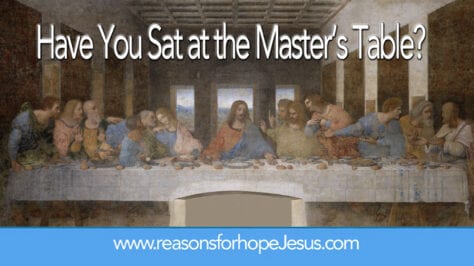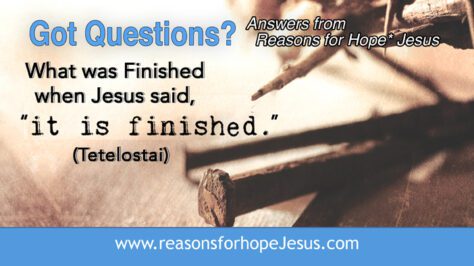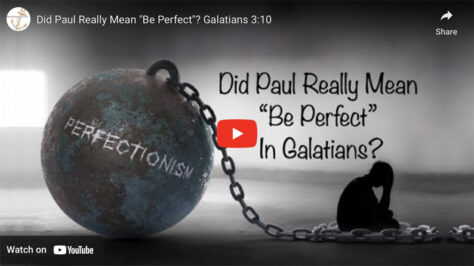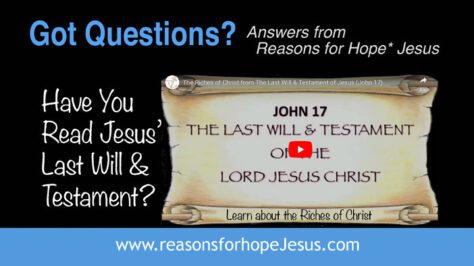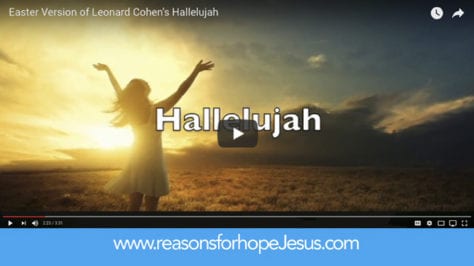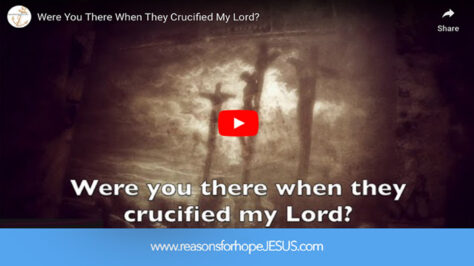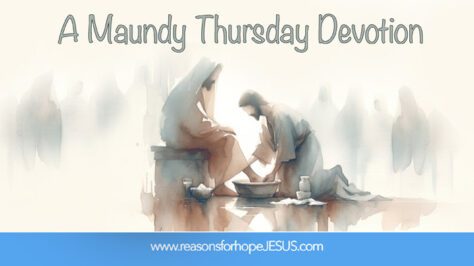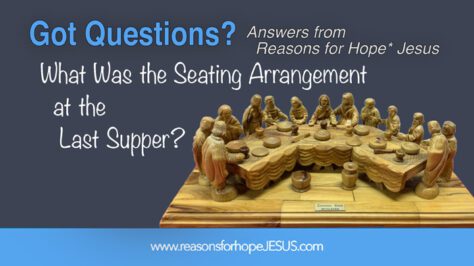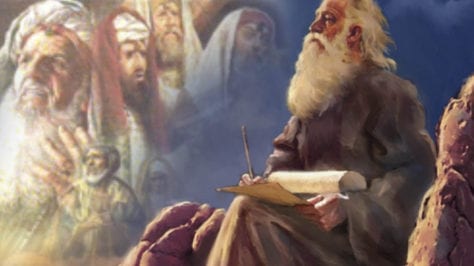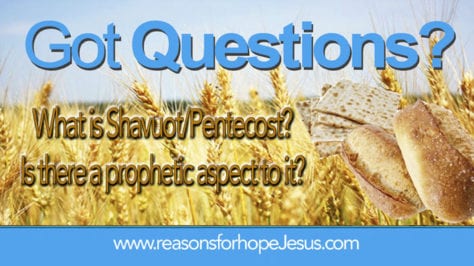
Shavuot is the second of three mandatory Jewish feasts ordained by God (Exodus 34:22). While the Jews call this feast Shavuot, in the New Testament, the Greek word is pentekoste (meaning fifty). From the Greek pentekoste, we get the English transliteration of Pentecost, which the church recognizes as the time when the Holy Spirit was given, and the Church was born.
This year, 2021, Shavuot begins on May 16th.
The Date, Time, and Offering of Shavuot
The date is set by counting seven Sabbaths (seven weeks=49 days) plus one day from the Feast of Firstfruits of the barley harvest of Passover. That would be a total of 50 days. (Leviticus 23:15-16). This would place Shavuot in the very late spring or early summer (mid-May to mid-June on our calendars) — the time of the wheat harvest in Israel.
Shavuot begins at sunset, which is the earliest possible definition of night/evening. Sunset is the time when the sun sets below the horizon. Shavuot is a one-day feast in Israel and a two-day feast elsewhere. Therefore, Shavuot ends at nightfall on the next day in Israel and at nightfall on the second day outside of Israel. Nightfall is marked by the appearance of three stars in the sky.
Because of the counting of weeks, Shavuot is also referred to as the Feast of Weeks. The counting “links” the significance of the Passover, (God’s deliverance of His people from Egyptian bondage) to God’s giving of the Law at Mt. Sinai 50 days later. Both Passover and Shavuot have a firstfruits offering of grain — barley at Passover and wheat at Shavuot. A firstfruits offering signifies giving back to God from that which He has given and thanking Him for the bountiful harvest. (There is also a fall feast, the Feast of Tabernacles, which is a celebration at the time of the fruit harvest.)
Typology in the Wheat Harvest at Shavuot
Israel was an agrarian culture, so Jesus often used horticultural themes in His teachings. Examples include the parable of the sower (Matt 13, Mark 4), the parable of the wheat and tares (Matthew 13), laborers in the fields (Matt 9:37-38, Luke 10:2), the lifecycle of a seed (John 12:24), and more. In John 4:35, Jesus told that the harvest will come when the fields are “white for harvest”
The 50 days, from the barley harvest to the wheat harvest, typologically represent the time of the church age, from the cross to the Rapture (read: What is the Rapture?) And the wheat, growing in the fields, represents the growing Church throughout the last two centuries.
Prophetic “Whispers” in Shavuot
I suggest, for your consideration, that in the firstfruits offering of the Feast of Shavuot there is a prophetic “whisper” of a future event.
During this feast, the Israelites were told to offer two loaves of leavened bread to the Lord (Leviticus 23:17). In contrast, during the spring feast of Passover, they were told to remove all leaven from their homes. Leaven represents sin in the Bible, so removing leaven from their homes is symbolic of removing sin from their lives. This raises the question:
Why, 50 days later at Shavuot, would God command the Israelites to offer two loaves of bread, baked with leaven?
While the Bible doesn’t give us the answer, there is biblical reasoning about why leaven might be acceptable to the Lord in the firstfruits offering of the wheat harvest. Before explaining, let’s compare the Feast of Passover and the Feast of Shavuot.
Feast of Passover/Feast of Firstfruits
- Seven-day feast.
- Set according to God’s prescribed date.
- Bread made without leaven, which represents sin (symbolic of repentance of sin)
- Commanded to remove all leaven from the home.
- The killing of the pure and spotless paschal Lamb (symbolic of the crucifixion of Jesus, the perfect Lamb of God)
- The Blood applied to the doorposts of the homes; the Angel of Death passing over the blood-covered homes (symbolic of the blood of our Lamb that covers the tabernacles of our bodies and removes our death curse)
- Passover commemorates God’s deliverance of Israel from bondage in Egypt (symbolic of our deliverance from sin and death)
- Firstfruits offering of a sheaf of grain from the barley harvest (symbolic of thanksgiving unto the Lord for His mighty works).
Shavuot/Feast of Weeks
- One-day feast in Israel (a two-day feast outside of Israel).
- Set according to the counting of weeks, (7 weeks of the counting of the omer) + one day of rest. The 50th day is the feast of Firstfruits of Passover.
- Shavuot commemorates God’s giving His people the Law at Sinai, 50 days after delivering them out of Egypt.
- Firstfruits offering of two loaves of leavened bread made from fine flour from the wheat harvest (the only leaven ever brought to the Temple and offered to God).
Why Would Leaven Be Acceptable to the Lord?
The answer is found in considering the typology. Yes, leaven does represent sin (e.g. the false doctrine of the Pharisees — Matt 16:12). Yet, at the time of Shavuot, leaven is put into the “fine flour” from the wheat harvest. The lump rises, it is baked, and it becomes a warm, aromatic, fresh loaf of bread that is offered to God. Let’s examine the typology.
The fine flour of wheat represents the Church, as mentioned above. The leaven still represents sin. However, when the lump of dough (fine flour mixed with leaven) is baked, it rises, and the leaven inside is unseen. As Christians, we are covered by the Bread of Heaven (John 6:51). Jesus took upon Himself our sins (thereby removing “leaven”), and He gave His life to pay for our sins. Jesus died and rose to glory. and He is the Bread of Life (John 6:35) who covers our sins.
God also commanded Israel to bake and offer not one but two loaves of leavened bread. Typologically, it’s considered that this represents the Church, which is made up of both Jews and Gentiles who appear the same in the eyes of God. During the church age, we who belong to Jesus still sin, but we are acceptable to God because when He looks upon a redeemed sinner, He does not see the leaven in us. He sees the perfect Bread of Heaven…HIS SON, the Lord Jesus Christ.
The firstfruits offering of this feast (the two loaves) were waved to the Lord. Typologically, this could represent the Rapture of believers at the harvest of the wheat (the Church).
The Advents of Jesus
We often refer to Jesus’ first and second advents as His first and second comings (to earth). In His first advent, He came to the lost sheep of the house of Israel (Mat 15:24). He came to fulfill the prophecies of a Jewish Messiah who would save His people. Sadly, the Jews did not receive Him (John 1:11). But in the seven-year period of tribulation that is yet to happen, a believing remnant of Jews will receive Jesus by faith and then Jesus will return, at the time of the Feast of Tabernacles, to set up His reign on earth. These are the two “comings” of Jesus — one at Passover, one at Tabernacles. But what about Shavuot? Could there be a coming of Jesus that will fulfill this feast?
Jesus Will Come for His Own
I suggest there will be a type of advent/coming at the Rapture that could fulfill Shavuot. In this advent, Jesus will come to His who are on earth, but He will not set His foot on the earth. We will meet Him in the clouds:
1 Th 4:16-17 For the Lord himself shall descend from heaven with a shout, with the voice of the archangel, and with the trump of God: and the dead in Christ shall [bodily] rise first: Then we which are alive and remain shall be caught up together [rapture] with them in the clouds, to meet the Lord in the air…
1 Cor 15:21, 23 But now is Christ risen from the dead, and become the firstfruits of them that slept. [at the time of Passover] For as in Adam all die, even so in Christ shall all be made alive [bodily resurrected]. But every man in his own order: Christ the firstfruits; afterward they that are Christ’s at his coming.
Jesus promised He will come for His own:
John 14:3 And if I go and prepare a place for you, I will come again, and receive you unto myself; that where I am, there ye may be also.
When we consider that Jesus’ first coming completely fulfilled the spring Feast of Passover, and His second coming will completely fulfill the fall Feast of Tabernacles, it seems very reasonable that the Feast of Shavuot has been only partially fulfilled with the birth of the Church (typologically, the bread has been made). And that it will be completely fulfilled when Jesus returns for His bride, the Church, and raptures His own to Heaven (typologically, the “bread” will be waved to God and received by Him).
Another Prophetic Whisper?
Jewish tradition offers another “whisper” of Shavuot being the time when the Rapture could occur.
- Jewish tradition says that Enoch was born at the time of Shavuot.
- The Bible says that Enoch was raptured by God (Gen 5:24)
- Jewish tradition claims Enoch was raptured at the same time of year as his birth.
So what could that mean?
- Typologically, Enoch is considered a “picture” or “whisper” of the primarily Gentile Church. (Enoch was a Gentile, predating Abraham. Enoch walked with God and was taken, i.e. raptured.- Gen 5:24)
- We know that the Church was “born” at the time of Shavuot/Pentecost. (at the same time that Jewish tradition claims Enoch was born)
- Could it be that the Church will be raptured at the same time of year that it was “born?” At the same time that Enoch was raptured?
Remember This
- Never forget that the Bible does not reveal when the Rapture will occur.
- While the reasoning for the Rapture being at the time of Shavuot/Pentecost is interesting and plausible, remember it is only reasoned thinking. It might be right. It might be wrong. But even if it is right, we only know the season (not the day or hour).
- The accuracy of all patterns and types can only be determined after the prophecies have been fulfilled.
- What we do KNOW is that the Rapture will take place in God’s perfect timing. And we know that we are to wait, being confident that Jesus is with us (Heb 13:5) and He is working in and through us (Phil 1:6).
Also, remember that not all Christians believe the same things regarding eschatology (end times). Do not allow differing views to become divisive. God calls us to study His Word, and we are promised that the Holy Spirit will open our understanding and teach us, but remember, our first and foremost calling is to glorify God by loving. We are to love God first and then love our neighbors. Jesus said, “By this, all will know that you are My disciples if you have love for one another.” (John 13:35 )
All Christians agree that Jesus is coming back and that He will make ALL things new. Let it be our united prayer, “come quickly Lord Jesus.” And, until He returns, let us be laborers in the wheat fields so His harvest will be plentiful. Keep looking up….
Looking for that blessed hope, and the glorious appearing
of the great God and our Saviour Jesus Christ; (Titus 2:13)
<*}}}><
Just for Fun
When doing research for my book, Who Said That? Common everyday sayings…where do they come from? I came across a lot of common idioms about wheat and bread. Idioms are a combination of words that provide a figurative meaning — usually to emphasize a point or to add “color” to a conversation.
To “separate the wheat from the chaff” is about the wheat harvest, and it means distinguishing what is useful or valuable (the wheat) from that which is not (the chaff). This saying originated in the Bible and is listed in the book Who Said That?
For fun, here are a few more (although these are without biblical origin).
- “Bread and butter” refers to the basics of life.
- “Bread and water” refers to the bare minimum of food and drink, based on the traditional punitive prison diet.
- “The greatest thing since sliced bread” is something considered revolutionary and indispensable.
- “Half a loaf is better than none” means that one shouldn’t complain about not having everything. One should be thankful for what one has because it is better to have something than nothing.
- “Half-baked” means “incomplete” or “not thoroughly planned or conceived.”
- To know “which side one’s bread is buttered on” is to recognize what is advantageous.
<*}}}><
Read More
What is the Rapture and is it biblical?
Why a Pre-Trib Rapture?
Will the Rapture Occur at Pentecost (Shavuot)?
Does a Wedding Ceremony Have Prophetic Typology of the Rapture?
When the Church is Raptured, Will Animals be Left Behind?
Why Do We Believe in a Pre-Trib Rapture?
What is the Seventieth Week of Daniel?
Does 2 Thessalonians 2:1-3 Suggest a Mid-Trib Rapture?
Verses about The Rapture: 1 Corinthians 15:52, 1 Thessalonians 1:10, 1 Thessalonians 4:13-15, 1 Thessalonians 4:16-17, 1 Thessalonians 5:1-5, 1 Thessalonians 5:9, 2 Thessalonians 2:1-2, Titus 2:13, Revelation 3:10
Read also: What are the Four Views of the End Times? A Pre, Post, and Amillennial Chart
*******
Jesus is the Reason this Ministry Exists
At Reasons for Hope* Jesus, we are committed to equipping, encouraging, and empowering Christians to know Jesus better, love Him more, and share their faith. We also reach the lost through our Salvation Page.
With your support, we can continue to provide valuable resources and engaging content. Please join us in our mission by donating today. Your generous contribution helps us expand our outreach of sharing biblical truths and hope in Jesus. Thank you for your kindness and for being an integral part of our mission.
*******
*******
***A Hidden Message in Psalm 23?***
Hidden in the six verses of Psalm 23 are 11 names for Jesus. When you subscribe to our newsletter, we’ll send you The Names of God in Psalm 23 PDF that reveals all 11 names and Scripture verses of comfort and hope (link will be sent in your confirmation email).
 A Room with a View of Eternity—The Last Will & Testament of Jesus Christ Take a seat at the Master's table. Learn about the riches He gives to all who are His. This book will bless and encourage you, give you hope, and help you live in the joy of your salvation and the riches of Christ that are yours.
A Room with a View of Eternity—The Last Will & Testament of Jesus Christ Take a seat at the Master's table. Learn about the riches He gives to all who are His. This book will bless and encourage you, give you hope, and help you live in the joy of your salvation and the riches of Christ that are yours.

The Top Ten Got Questions? in 2023
- The Meaning of NUMBERS in the Bible?
- Was Jesus CRUCIFIED on Wednesday, Thursday, or Friday?
- How was Jesus Like a Worm? What’s the CRIMSON (OR SCARLET) WORM in Psalm 22?
- How are the Shepherd’s ROD and STAFF Different?
- How long did JOB SUFFER?
- What is the Significance of the Wise Men's THREE GIFTS? And were they kings?
- Did The Wise Men Arrive 12 DAYS AFTER JESUS’ BIRTH? Or Was It Much Later?
- Jesus’ Last Days TIMELINE: the Cross and the Resurrection
- The Meaning of COLORS in the Bible?
- Did Jesus Fight Satan to Take Back the KEYS of Death and Hell?
There is much to be learned from those who have gone before us in the faith. Check out our Cloud of Witnesses category that features the words of departed saints who are now with the Lord in glory. Their words equip and encourage us even to this day. Take a few minutes to hear...
- ONLY ONE LIFE, Twill Soon Be Past – by C.T. Studd (1860 – 1931)
- “The Love of God is Greater Far” by Frederick M. Lehman (1917)
- Prayers from Billy Graham
- Who Was Robert Robinson? What’s the Story Behind “Come Thou Fount”
- “Immanuel” — A Poem by Charles Spurgeon (1834-1892)
- Who Am I? A Poem by Deitrich Bonhoeffer (1905-1945)
- Understanding the Everlasting Arms of God, by J.R. Miller (1840–1912)
- 24 Reasons Why I Love America, by John Wayne (1907-1979)
- Give Me Perpetual Broken-heartedness (from The Valley of Vision)
- Abide with Me, by James Smith, 1859
This remains one of our most popular pages viewed.![]()

TOP TEN Videos from Reasons for Hope* Jesus
- Memorial Day BAGPIPES TRIBUTE: Amazing Grace
- RISE AND SHINE and Give God the Glory, Glory!
- WERE YOU THERE When They Crucified My Lord?
- PAUL HARVEY: THE BIRDCAGE
- PRESIDENT RONALD REAGAN: A SOLDIER'S PLEDGE
- Hark! the Herald Angels Sing -- CHARLIE BROWN Christmas
- JOHN WAYNE ~ WHY I LOVE AMERICA
- Jimmy Stewart - Nativity Scene Prayer: Mr. Krueger's Christmas
- THE LEGEND OF THE CANDY CANE - A Christmas Story to Share
- Not by Might, Not by Power, But BY MY SPIRIT says the Lord (Zechariah 4:6)
*****************








